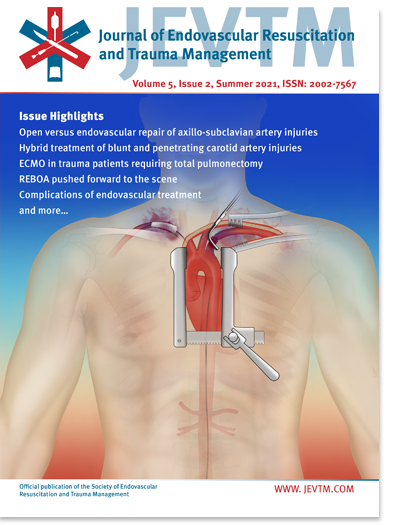A Practical Approach to Introducing Pre-Hospital Resuscitative Endovascular Balloon Occlusion of the Aorta (REBOA), the Problems Encountered and Lessons Learned
DOI:
https://doi.org/10.26676/jevtm.v5i2.207Keywords:
REBOA, Resuscitation, Trauma, Haemorrhage, Pre-hospital Care, EndovascularAbstract
Resuscitative Endovascular Balloon Occlusion of the Aorta (REBOA) is an endovascular procedure which utilises a catheter- based balloon device to achieve aortic occlusion. The aim of this resuscitative measure is to improve blood pressure proximal to the occlusion site and therefore preserve cardiac and cerebral perfusion to prevent cardiac arrest. In addition, there is a relative reduction in arterial flow to the site of injury distal to the balloon. Endovascular techniques are gaining acceptance for the in-hospital management of haemorrhage; however, their use in pre-hospital care is still limited. This is due to several factors including the technical challenges, training and skill sets of pre-hospital care teams and the potential for harm of REBOA, particularly with extended balloon occlusion times. However, non-com pressible torso haemorrhage is associated with a mortality of approximately 50% and a significant proportion of these deaths occur in the pre-hospital phase of care. In the exsanguinating patient, resuscitative thoracotomy with direct aortic compression is often the only means to control haemorrhage. This resuscitative measure is now a more established pre-hospital intervention which has significantly improved outcomes in the context of penetrating trauma, particularly thoracic injury. However, in the context of blunt injury and subdiaphragmatic haemorrhage, the outcomes from pre-hospital resuscitative thoracotomy remain poor. We present our initial technique for successfully introducing REBOA for the pre-hospital management of exsanguinating pelvic or groin haemorrhage following trauma, our indications for REBOA and comments on the problems and limitations encountered, as well as the lessons learned.
Published
How to Cite
Issue
Section
License
Copyright (c) 2021 Journal of Endovascular Resuscitation and Trauma Management

This work is licensed under a Creative Commons Attribution-NonCommercial 4.0 International License.
Authors of content published in the JEVTM retain the copyright to their works.
Articles in the JEVTM are published under the terms of a Creative Commons CC BY 4.0 license, which permits use, downloading, distribution, linking to and reproduction in any medium, provided the original work is properly cited.




